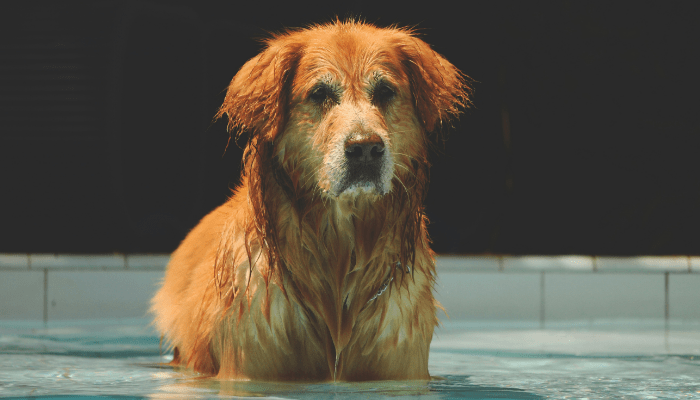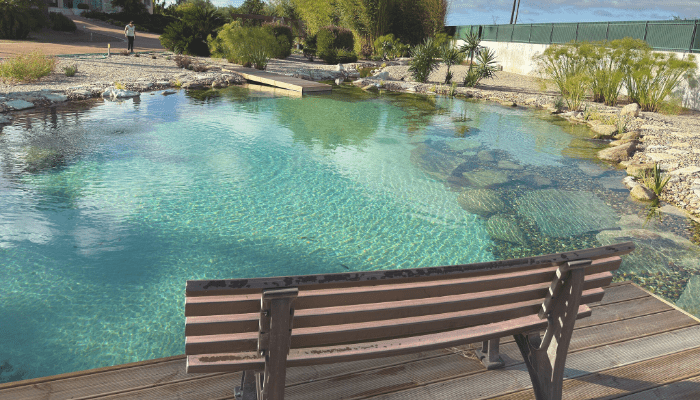Key Takeaways
Not all dogs swim well. Breeds with heavy bodies or short snouts often struggle, and even strong swimmers tire quickly.
Supervision is essential. Never leave your dog alone near a pool. Install fences, alarms, or barriers to block unsupervised access.
Teach safe exits. Practice using steps or ramps (like PetStep or Dog‑DOK) until your dog can confidently climb out.
Use safety gear. Dog life jackets with handles and non‑slip ramps add protection and make rescues easier.
Watch for distress. Frantic paddling, low head position, or climbing at the walls mean your dog needs help immediately.
Rinse after swims. Chlorine and salt can irritate skin, paws, and ears, rinse and dry thoroughly after each session.
Be prepared. Learn canine CPR, keep a first‑aid kit poolside, and have vet numbers handy.
Prevent water intoxication. Limit swim sessions, discourage gulping pool water, and offer fresh drinking water nearby.
Balance chemicals. Avoid swimming right after treatments and use pet‑safe products where possible.
Make it positive. Introduce swimming gradually with treats, toys, and praise so your dog associates the pool with fun and safety.
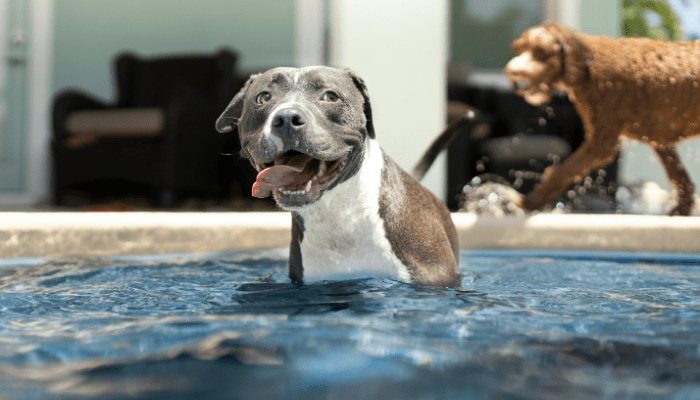
Dogs don’t drown because they can’t swim. They drown because they can’t get out. That line stuck with me the first time I heard it from a vet and it perfectly sums up why pool safety for dogs matters so much.
We assume our dogs are fine around water. They’re natural swimmers! They chase toys, splash around, and seem right at home. But the reality is this: pool safety for dogs isn’t optional. Even strong swimmers can panic, get tired, or fail to find the exit in time.
Every summer, countless dogs end up in emergency clinics from water-related accidents—not dramatic rescues, but silent, preventable incidents. A missed step. A slippery ledge. One moment of distraction.
This guide is about preparation, not paranoia. Pool safety for dogs means giving them the tools, training, and supervision to enjoy the water confidently and come back out just as safely.
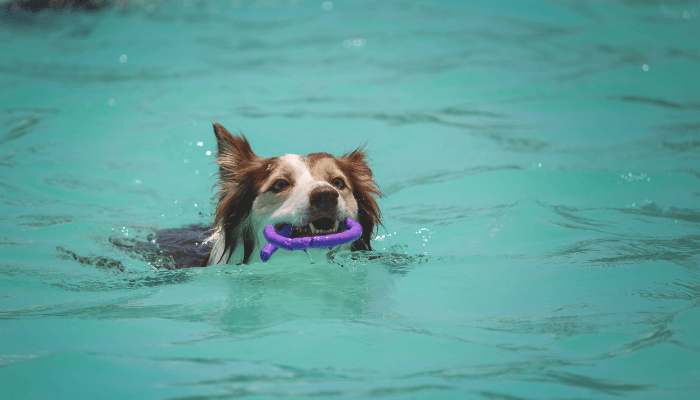
Can All Dogs Swim? Not Exactly
It’s a common misconception that all dogs are natural swimmers. While some breeds like Labradors and Golden Retrievers take to water with enthusiasm, others, such as Bulldogs, Pugs, and Dachshunds, may struggle due to their body structure. Even if your dog is a confident swimmer, fatigue can set in quickly, leading to dangerous situations. Always assess your dog’s swimming ability and comfort level before allowing them near the pool.
Supervision Is Non-Negotiable
Never leave your dog unattended around the pool. Accidents can happen in seconds, and even experienced swimmers can get into trouble. Ensure that someone is always watching your dog when they’re near or in the water. Consider installing a pool fence or using a pool alarm to prevent unsupervised access. These precautions can be lifesaving.
Teach Your Dog to Enter and Exit Safely
Knowing how to get in and out of the pool is crucial for your dog’s safety. Many dogs can enter the pool easily but struggle to find a way out, leading to panic and potential drowning. Train your dog to use the pool steps or a ramp to exit the water. Practice this regularly until your dog is comfortable and confident. Products like the PetStep Pool Ramp can provide a safe and easy exit point for your dog.
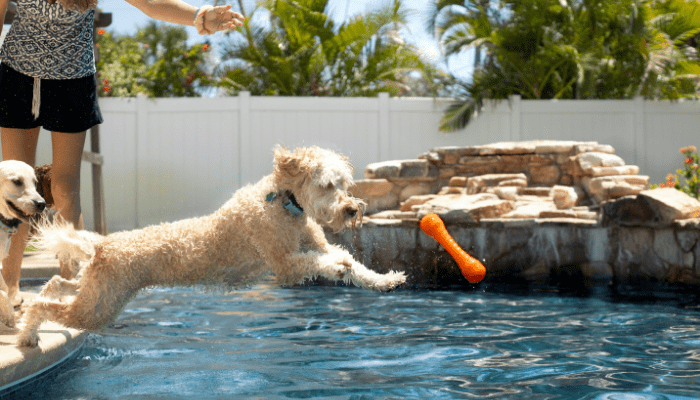
Use Dog-Friendly Pool Accessories
Investing in the right pool accessories can enhance your dog’s safety and enjoyment. Dog-specific life jackets provide buoyancy and have handles for easy retrieval. Ensure the life jacket fits properly and doesn’t restrict movement. Additionally, consider using non-slip pool ramps or steps designed for dogs to prevent slipping and provide secure footing. The Dog-DOK Inflatable Dog Water Ramp is another excellent option for safe water access.
Know the Signs of Water Distress
It’s essential to recognize when your dog is in trouble in the water. Signs of distress include frantic paddling, low head position, and attempts to climb the pool walls. If you notice any of these signs, assist your dog immediately. After a water incident, monitor your dog for symptoms of water ingestion, such as coughing, lethargy, or difficulty breathing, and consult your veterinarian if needed.
Protect Paws, Eyes, and Skin
Pool chemicals like chlorine can irritate your dog’s skin, eyes, and paws. After swimming, rinse your dog thoroughly with fresh water to remove any chemical residue. Dry their ears to prevent infections, especially in breeds prone to ear issues. Regular grooming and maintenance can help keep your dog’s skin and coat healthy. For more information on post-swim care, refer to PetMD’s safety tips.
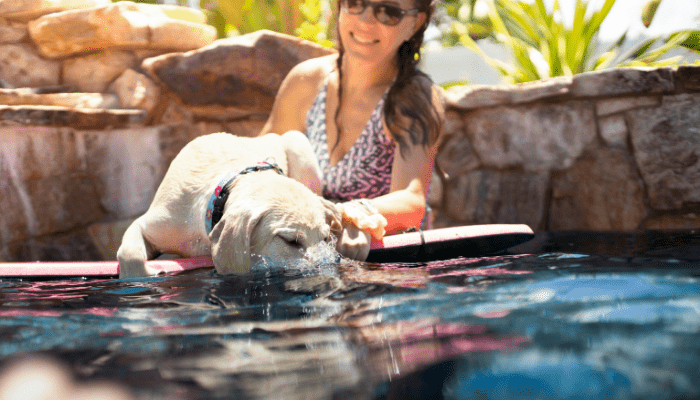
CPR and Emergency Preparedness
Being prepared for emergencies is vital. Learn how to perform canine CPR and keep a pet-specific first aid kit near the pool. Ensure that emergency contact numbers, including your veterinarian and the nearest emergency clinic, are easily accessible. In case of an accident, quick and informed action can make all the difference.
Create a Safe Pool Zone
Dogs don’t always understand boundaries, especially when water is involved. If the pool is accessible 24/7, accidents can happen when no one’s watching.
Install a pool fence with a self-closing gate, or set up a barrier like a baby gate if your pool is above ground. If your dog’s clever (read: sneaky), consider motion-sensor alarms or pool entry alerts that let you know when something, or someone, enters the water unexpectedly.
You can also train your dog to associate pool access with a verbal command or a leash release, reinforcing that swimming is something they do under supervision.
Be Aware of Water Intoxication
Yes, dogs can drink too much water, and no, it’s not as rare as people think.
Water intoxication happens when a dog swallows excessive amounts of water while playing or swimming. It can dilute sodium levels in their blood, leading to symptoms like bloating, staggering, vomiting, or even seizures. It’s most common in smaller dogs or those who obsessively bite at water.
Keep swim sessions short (10-15 minutes), take regular breaks, and discourage your dog from gulping mouthfuls of pool water. If you see any signs of discomfort, stop the activity and call your vet immediately.
More on this from East Dallas Vet Clinic.
Keep Pool Chemicals Dog-Friendly
Most properly balanced chlorine pools are safe for dogs, but that’s assuming the chemicals are well-managed.
Avoid letting your dog swim right after you’ve shocked the pool or added algaecide. These chemicals can irritate their skin, eyes, and digestive system if ingested. Saltwater pools, while often marketed as “softer,” still contain chlorine and salt levels that can cause dehydration or digestive upset in dogs who drink too much.
Keep your water levels balanced, use pet-safe pool products when possible, and discourage drinking directly from the pool by providing a fresh bowl of water nearby.
More from PetMD.
Watch Out for Post-Swim Zoomies
The swim’s over, the towel’s out… and suddenly your dog is tearing around the yard like it’s training for a cartoon race.
This is totally normal, post-swim zoomies are a thing, but they can turn risky fast if your dog slips on wet surfaces or crashes into furniture, fences, or people. Dry your dog off thoroughly, give them a calm space to wind down, and avoid letting them run on slick tiles or wood decks.
Bonus tip: if you’re having guests over, let people know in advance so no one spills their margarita during the canine speed lap.
Bonus: Make the Pool a Positive Experience
Encourage your dog to enjoy the pool by creating positive associations. Use treats, toys, and praise to make swimming a fun activity. Never force your dog into the water, as this can create fear and anxiety. Allow your dog to explore at their own pace and always prioritize their comfort and safety.
By implementing these safety measures, you can ensure that your dog enjoys the pool safely and confidently. Remember, proactive planning and supervision are key to preventing accidents and keeping your furry friend safe.
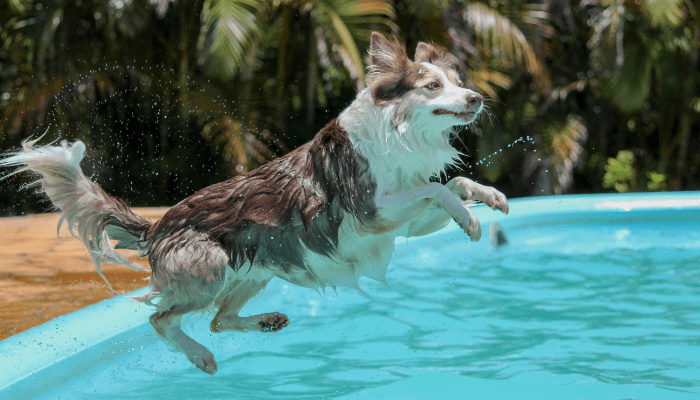
Conclusion: Pool Safety for Dogs
Let’s be clear: you don’t need to be a vet or lifeguard to master pool safety for dogs. You just need awareness, a few smart tools, and habits that stick.
Start with clear boundaries. Train your dog to exit the pool safely. Add a ramp, keep towels nearby, and watch closely, especially when they’re tired or overstimulated. That’s when most accidents happen.
You don’t need to redesign your backyard. Just approach it with pool safety for dogs in mind. If something feels confusing, slippery, or stressful to your dog, it’s probably unsafe.
But when you get pool safety for dogs right? You’ll see the difference: a happy, confident dog who can leap in, paddle like a pro, and climb out without fear. Tail wagging, ready for more.
Because safety isn’t about saying “no.” It’s about making “yes” possible, safely, every single time.
Pools should be safe for every family member with paws included.
Oásis Biosistema designs smarter, safer pools with features that keep pets and people protected.
FAQ
How do I make my pool water safe for my dog?
To make pool water safe for your dog, maintain balanced chlorine levels (1-3 ppm) and proper pH (7.2-7.8). Avoid over-chlorination and rinse your dog after swimming to protect its skin and coat. Use pet-safe chemicals and ensure your dog drinks fresh water, not pool water.
Is a swimming pool safe for dogs?
Yes, swimming pools can be safe for dogs if properly maintained. Supervise your pet at all times, ensure easy entry/exit points, and keep chlorine levels within safe limits. Rinse your dog afterward to prevent skin irritation and monitor for signs of fatigue or swallowing too much water.
How to dog proof a swimming pool?
Dog-proof your pool by installing a safety fence or pool cover, using a pet ramp or steps for easy access, and training your dog to exit safely. Supervise swimming, secure chemicals out of reach, and use alarms or motion detectors to prevent unsupervised access to the pool.
How long after swimming can a dog eat?
Dogs should wait at least 30 to 60 minutes after swimming before eating. This helps prevent bloating, especially in larger breeds. Allow your dog to cool down, rest, and hydrate with fresh water before offering food to ensure safe digestion and avoid stomach discomfort.

